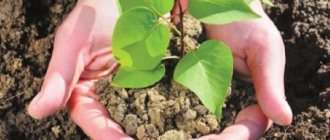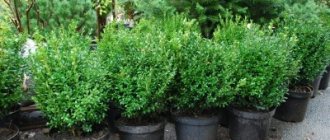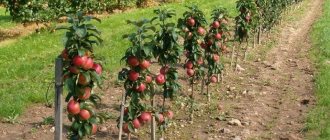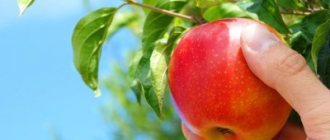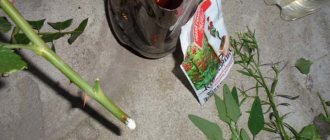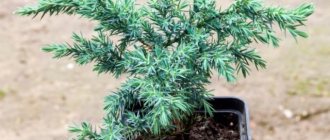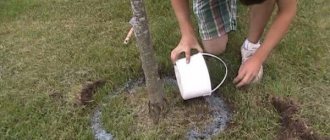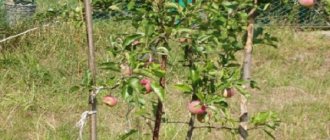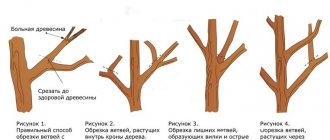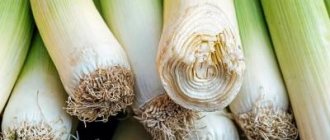Grafting is a very popular technique among gardeners. It allows you to breed hybrid and dwarf varieties, improve the frost resistance of cold-sensitive apple trees, revive old trees, and simply save space in the garden. Grafting is quite simple; the main difficulty is preparing the cuttings correctly.
A cutting is a one-year young sprout - from 3 to 10 years old, of a well-fruiting apple tree. For grafting, shoots are cut 30–40 cm long and at least 7 mm in diameter. The sprout retains from 3 to 5 developed buds. The cuttings take root well on the mother plant. The method involves creating tight contact between the cambium of the sprout and the main tree. Under other favorable conditions - warm, stable weather, sufficient watering and fertilizing, the cutting will certainly take root and will be ready to bear fruit the next year.
When is the best time to cook cuttings?
Some gardeners believe that it is better to prepare cuttings in the spring. During the winter, the weaker ones freeze out, and the strongest ones, on the contrary, become stronger and more resilient. This can be done at the end of February - March. Very convenient to combine with spring pruning. The main thing is to do this after severe frosts, before the sap begins to flow, before the buds begin to wake up.
Others are of the opinion that autumn preparations are more reliable. They are carried out after the first frost to –1 °C, when the tree “fell asleep”. This way you will protect it from freezing of young branches during a harsh winter, and there will be a guarantee that the scion will not wake up before the operation itself. Another important positive point is that some microbes and fungi die in the cold.
Until grafting time, the cuttings should be dormant.
How to prepare apple tree cuttings in the spring and when it is time for grafting, where to store
In the life of every gardener, beginner or experienced, there comes a time when it is necessary to graft fruit trees. Apple trees are considered to be common inhabitants of gardens, which the owners of the site often have to deal with. Preparing cuttings for grafting an apple tree has many subtleties, knowledge of which will facilitate the process and allow you to stock up on good raw materials. Before you go to harvest the scion, it is recommended that you familiarize yourself with the features of the process, the rules, and the advice of experienced gardeners.
Rules for cutting apple cuttings
To take cuttings, choose annual shoots that grow at an angle. Thick straight branches that grow perpendicularly upward with poorly developed buds will take root well, but you won’t have to expect a good and quick harvest from such a scion. Shoots from which the leaves and petioles have not fallen before the frost should not be taken either, they have not yet ripened. Prepare a very sharp tool - a pruning shear or a garden knife. Before work, be sure to treat it with any disinfecting solution to avoid infection. Cut the cuttings with a reserve so that in the spring you can choose better-preserved, stronger ones. Prepare pieces 30–50 cm long, 7–10 cm in diameter, with 3–7 well-developed buds. The top cut is made above the eye. A piece from an old tree can be about 15 cm long, but there should be at least three buds.
Do not touch the cut area with your hands under any circumstances. Otherwise, you can get an infection.
Preparation of apple tree cuttings for grafting in spring
Spring cuttings for grafting apple trees are possible after the end of severe frosts, which in most regions refers to mid-March, or even the end of February. Since this is the time when most gardeners do detailed tree pruning, choosing the best cuttings is not a problem. Can I do this later? Yes, in principle, it is possible, the only important thing is to do it before the buds open: in this case, all the work will be useless.
I have been re-grafting my trees from time to time for about thirty years now, and quite successfully. I must say, I rarely prepare cuttings in advance. And although there is an opinion that the chopped material should first “lie down,” most often it is only in April (you can’t get to the dacha earlier), when sap flow has begun and the buds have swelled, to cut off the necessary cuttings from one tree and immediately graft it onto another. Whether this is right or wrong is for experts to judge, but I have never experienced failure.
What cuttings to take for grafting an apple tree
Before choosing branches for cuttings, you need to correctly decide on the donor apple tree. It is advisable that it is not yet an old tree, between 3 and 10 years old. It is during these years that the apple tree is the strongest, healthiest, and most intensively growing. But since at the age of three not every variety has time to bear fruit, it is better to wait to make sure that this tree is of the required variety.
Usually there is still snow in March, but at this time a well-groomed apple tree allows you to choose the right cuttings for grafting
After all, how often does it happen that we buy something planned for a long time, but in the end we get another Melba or Northern Synapse! These are, of course, good varieties, but the question is that even in nurseries, deliberate or accidental deception is possible. Therefore, when buying fruit tree seedlings, I am never sure that I will get what I want until I collect the first fruits.
So, the apple tree produced the first apples, they turned out to be tasty and beautiful, let’s wait another year. If next year’s harvest is already decent, you can definitely take cuttings from this tree for grafting. It is better to approach the apple tree from the most illuminated side: on it the branches ripen better and have greater growth power. You should not cut cuttings from the lowest and highest tiers. You need to choose strong annual shoots, thick, with short internodes.
You should not use tops (strong fatty shoots that grow almost vertically upward) to cut cuttings! The grafting will most likely be successful, but the yield may be low, and you will have to wait many years for the first apples.
All buds on the cut branches should be large, healthy, and well developed. The terminal bud should also be strong, although it will not necessarily remain as part of the cutting. If leaves or even petioles remain on a branch after winter, you should not take cuttings from it: such a branch most likely has not matured well. The thickness of the cutting should be about 6–8 cm, cut into sections 30 cm long, with at least four buds (the excess will be cut off during grafting).
The main tool when cutting cuttings is a clean, sharp pruner; you can cut a piece of a branch with a section of two-year-old wood, but use only a one-year-old cutting
When cutting cuttings, you need to carefully examine their core: any darkening or brown spots may indicate freezing of the branches; such cuttings may not take root on the new tree. Naturally, there should be no damage to the bark, and the cuttings themselves should be almost straight, without strong bends.
Is it possible to take cuttings from an old tree that is 25 years old or more? Most likely, they will take root, but the choice of branches for cuttings must be approached more responsibly, and more cuttings must be prepared. As a rule, the annual shoots themselves in this case are thinner and shorter, but their growth vigor on the new tree will not always be lower. Therefore, if there is no other choice, and the old tree is quite healthy, you can take cuttings from it.
Let the cutting be thinner than optimal for grafting, it’s still better than a thick top
Is it possible to take cuttings from two-year-old branches? Oddly enough, such vaccinations are sometimes obtained, although they are not recommended by experts. Still, it’s better not to take risks: one-year growth can be found on any apple tree, and if it’s practically absent, it means the tree is so weak that it’s better not to take cuttings from it.
Despite the fact that when pruning fruit trees, it is recommended to cover only cuts with a diameter greater than 2 cm with garden varnish, it would be a good idea to cover even the cuts from cuttings, especially if you have produced a lot of them and there is little time left before the sap flows. The apple tree will more easily bear parting with its last year's growth.
Recent Entries
5 working ways to use tar in the garden 7 indoor plants that help you get married even in adulthood Indoor plants that can bloom in trouble
Video: what should a cutting be like for grafting?
Do I need to soak apple tree cuttings before grafting?
Regardless of the time of cutting the cuttings and how long they were stored before grafting, it is better to refresh them before carrying out a responsible operation. Although, ideally, properly preserved cuttings should be elastic and retain their original moisture, they should be soaked in sweetened water before grafting. Usually, even perfectly preserved cuttings require 10–12 hours of soaking, and even more for dried ones.
During soaking, the cuttings should be saturated with moisture. Indirect indicators that this happened are:
- flexibility of cuttings when bending;
- absence of crunching or crackling during the same procedure;
- slight pressing of the bark when pressed with a fingernail;
- the appearance of microdroplets of moisture when making a new cut on the cutting.
The water for soaking should not be warm: it is better to use melted ice or snow water. Firstly, melt water contains certain substances that stimulate the growth of all living things, including the engraftment of grafts. Secondly, the cuttings must be saturated with water, but not cause early bud bursting, which can be stimulated by heating. Therefore, even for these 10–12 hours (essentially overnight), it is better to put the cuttings in sweet water in the refrigerator.
Some gardeners simply put the cuttings in a jar of water: this is possible, but it seems more correct to bathe them entirely in a nutrient solution
Why sweet? Why sugar? Yes, you can do without it, but, firstly, it provides some carbohydrate nutrition for the cutting, stimulating its further vital activity. Secondly, sugar forms a protective film on the cut of the cutting, which prevents rapid drying and penetration of pathogenic microbes into the cutting. Therefore, it’s still worth adding 1-2 tablespoons per liter of water.
Instead of sugar, you can use bee honey (1 tablespoon of flower honey per liter of water), which is even better, since it contains biologically active substances. They stimulate the growth of grafts and protect cuttings from pathological microorganisms.
General storage rules
- To avoid confusion, sign each bundle twice. Write the name of the variety on one label and the serial number on the second. Wrap the labels with tape to protect them from moisture. And duplicate in a notepad: number - name.
- Freezing or waking up early should not be allowed. Monitor storage temperature. At rest, the cuttings will lie for a long time at 0…+3 °C.
- It doesn’t hurt to lubricate the cut of the cutting with garden varnish. This will help prevent drying out.
Depending on the area and your preferences, you can store cuttings in different ways.
When is the best time to take cuttings?
Cuttings for grafting are prepared in autumn or spring. In the fall, this should be done when the flow of sap in the tree ends, that is, around the end of November. The question of whether it is worth taking cuttings in winter is the subject of much debate, so it is better for a novice gardener not to conduct such experiments.
In spring, this should be done after the end of frost, when the sap begins to circulate. Cuttings for grafting an apple tree can be taken during spring pruning, especially if it is a frost-resistant variety. On average, it is best to prepare apple tree cuttings for grafting in the spring in March, in the second half of the month, although this period may vary depending on the region and how long the winter was. The grafting material must be prepared before the buds open, otherwise there is almost no chance that it will take root. In general, it is recommended to harvest cuttings mainly in the fall - this way there is less risk that the shoots will freeze in winter, after which they will no longer be useful for grafting.
Outdoors or in the snow
Behind the northern wall (the snow will lie here longer) you need to dig a small trench 30–40 cm deep. Cover the bottom with pine branches, lay the prepared cuttings, and cover the top again with a layer of pine needles. Then cover our “treasure” with earth, sawdust or straw. The height of the snow cover should be at least half a meter.
You can do without picking in the ground, but then the snowdrift needs to be covered with a thick blanket of sawdust or straw so that it does not melt longer.
To protect cuttings from rodents, you can wrap them in a layer of fiberglass, old nylon tights, plastic or metal fine mesh.
On the street in frozen sawdust
If your region has winters with long thaws, try this method. To prevent damage to the skin of the cuttings, place them in a plastic bottle or a piece of polypropylene pipe, or simply wrap them in several loose layers of film. Leave holes for free air access. Behind the building on the north side, place a 10–20 cm layer of wet sawdust directly on the ground or burlap. Place your workpiece in the middle. Cover the top with another layer of wet sawdust. Leave it so that this cocoon freezes. After this, pour up to 40 cm of dry sawdust on top and cover with polyethylene. All, “don’t wake me up until spring!” A couple of days before vaccination, this structure should be moved to a warm place for gradual thawing.
Selection of cuttings
What does a correct cutting look like? First of all, you need to know that its size should be from 30 to 40 cm, and its thickness should be about 10 mm. Each cutting should have up to 7 developed buds. You should also pay attention to the internodes - it is advisable that they be short, since this determines how the scion will take root. The tree or shrub from which the cutting is taken must be young and fruit-bearing, up to 10 years old, but not younger than 3.
Gardeners recommend preparing more cuttings than necessary. This should be done in case not all cuttings can be saved.
Cuttings should be taken only from those trees and shrubs that are pruned in a timely manner. They have good growth with apical and lateral buds. In the event that cuttings have to be taken from young plants where a full-fledged crown has not yet formed, you need to use those branches that are scheduled for removal in the spring. This way the culture itself will not suffer.
Preparing grape cuttings for storage and subsequent grafting is not very different from preparing cuttings of fruit trees, but has some nuances. It is recommended to cut from the middle part of the fruiting vine. Grape cuttings can be stored all winter, and in the spring they can be placed in water to awaken.
Two ways to store in the cellar
- The cuttings, cut side down, are lowered into a bag and covered with damp sawdust (preferably pine), moss or sand. Leave the bag slightly open to allow the workpiece to breathe.
- We place the wet substrate in a box with holes for air circulation, place our workpieces horizontally and pour them on top.
Humidity is considered normal if, when you squeeze the substrate in your fist, it is felt, but water does not drip. If necessary, you can periodically add moisture to the containers or simply place a bucket of water next to it.
To repel mice and other rodents, you can add carbolic acid (50–60 g per 10 liters of water) to the water that is poured over sawdust or sand.
Storing cuttings in winter - what do you need to remember?
Once the cuttings are cut, tie them into bundles and hang labels on them (cardboard labels covered with tape or wooden signs are suitable for this) with the names of the tree varieties. This way you will definitely not confuse the planting material.
When saving cuttings for grafting, remember that they should not freeze or dry out. Also, rodents should not reach them. But just in case, prepare more cuttings than you plan to use, because they may not “survive” the winter in full force.
It is very important to clearly know how to store cuttings so that they survive until grafting. There are several methods - choose the one that is available to you.
Storing cuttings in the snow
If snow cover persists all winter in your region, you can safely store the cuttings in the snow. Dig a small trench (hill) 30-35 cm deep, cover it thickly with spruce branches, lay out the cuttings, and cover it again with pine needles. The final touch is to cover it with earth, sawdust or straw, and when snow falls, throw it on top. Keep in mind that the thickness of the snow cover above the hidden cuttings should be about 50 cm.
To prevent rodents from encroaching on the cuttings, wrap the planting material with fiberglass or ordinary nylon tights
Storing cuttings outside in frozen sawdust
This method of storing cuttings is suitable for western and southwestern regions with prolonged thaws. Choose a location on the north side of the site and sprinkle a sufficient amount of wet sawdust on the ground. Place the cuttings on them, and also sprinkle a layer of wet sawdust on top. This “fur coat” should be in the cold. Then cover it with a 40-centimeter layer of already dry sawdust. The top layer is polyethylene.
Sawdust retains moisture well and thereby creates an environment favorable for storing cuttings
To protect the cuttings from rodents, you can moisten the sawdust not with water, but with a solution of carbolic acid (50 g per 10 liters of water). Mice and rats will not like this “aroma”.
Storing cuttings in the cellar
Place the lower ends of the chopped and sorted cuttings in sawdust (place bundles of cuttings with the cuts down in a plastic bag and sprinkle with wet sawdust without tying it up) or in sand (place the cuttings in a wooden box with small holes and fill their lower part with wet sand). To prevent the cuttings from becoming moldy or dry out, make sure that the temperature in the cellar is from 0 to 1°C and the humidity is between 65-70%.
Cuttings must be stored at a temperature of 0 to 1°C
When storing grape cuttings, the temperature should be from 1 to 4°C. In such conditions, the chibuki will last well until mid-March.
An important condition is maintaining normal substrate humidity. How to determine the degree of moisture? Squeeze the substrate lightly in your hand - if it is damp, but no water drips from it, everything is fine.
Storing cuttings in the refrigerator
The most uncomplicated way of storage. But, as a rule, in such conditions, the grafting material is stored no longer than until the end of February - in March the buds “wake up”.
Place bunches of cuttings in a plastic bag, pre-wrapped with a damp cloth, and place in the refrigerator. If it is possible to regulate the temperature, set the value no higher than 2°C.
When storing cuttings, it is important to ensure that they are sufficiently moistened
Unusual ways to store cuttings
If you are smart, you can find a few more places where the cuttings will last until spring. For example, some gardeners wrap the cuttings in a clean plastic bag or put them in a plastic bottle and hang them on a balcony, veranda, outside the window of a city apartment, or on a tree growing near the house. The main thing is that there is a suitable temperature and humidity for the cuttings.
Cuttings in the refrigerator
If there are few cuttings or it is not possible to go to the dacha in winter and control the storage conditions there, you can use a home refrigerator. A bunch of cuttings is wrapped in a slightly damp cloth, you can additionally wrap it with a layer of paper, placed in a bag and placed in a colder compartment (usually closer to the freezer). It is necessary to make holes in the bag so that the branches do not suffocate. Such a treasure must be checked approximately once every 7-10 days.
If mold or diaper rash appears, wipe the cuttings with a soft cloth and dip them in a weak solution of potassium permanganate for 10–15 minutes.
Which plants propagate well from cuttings?
Not all crops in the garden can be propagated from cuttings, but there should be no problems with these plants. Have you ever tried to propagate plants from cuttings? Take a risk, and you will like it, because it doesn’t require much work, and it helps you save a lot on seedlings.
| Plant name | Cutting time | Beginning of rooting of cuttings |
| Privet | June | Immediately after preparation |
| Buddleya | After flowering | Immediately after preparation |
| Elder | End of June – beginning of July | Immediately after preparation |
| Weigela | April May | Immediately after preparation |
| Grape | During autumn pruning | End of February – March |
| Hydrangea | From the end of May to the end of July | Immediately after preparation |
| Maiden grapes | From May to July | Immediately after preparation |
| Deytsia | October November | April May |
| Honeysuckle | During the period of berry appearance | Immediately after preparation |
| cotoneaster | Second half of July | Immediately after preparation |
| Clematis | End of May – beginning of June | Immediately after preparation |
| Bloodroot | End of June – end of July | Immediately after preparation |
| Roses (groundcover, climbing, others) | End of June – beginning of July | Immediately after preparation |
| Boxwood | From July to March | Immediately after preparation |
| Currants (black and red) | From November to March | As soon as the soil thaws |
| Snowberry | November December | April |
| Spirea | September October | Immediately after preparation |
| Thuja | October | Immediately after preparation |
| Forsythia | From November to February | April |
| Chubushnik | Summer or autumn | Immediately after harvesting or in April |
Interesting articles on the topic:
How to cover grapes for the winter correctly Roses covering for the winter and pruning Do perennial flowers cover for the winter, when and how to do it How to save seedlings until spring [if you didn’t have time to plant them in the fall]
Online store Fazenda plus
Where else can you store cuttings?
In general, you can store cuttings almost anywhere. The main thing is that the temperature is maintained from 0 to 3 degrees, humidity and air access are ensured. Often, potential scion packaged in bottles, bags or boxes is stored on verandas, balconies, and even hung on trees and outside the window. Buried in a bag of potatoes. Also, a potato tuber can be used to prevent the cut from drying out and waking up early by placing it inside (in other words, sticking it in). Such cuttings will not only be well preserved, but will also be saturated with useful substances that promote the formation of roots; their survival rate is higher. All of these options are good, but there is a risk of freezing or, conversely, excessive heating in warm weather or in the sun. In any case, such workpieces must be regularly checked for moisture, mold and other troubles.
Why do cuttings spoil?
Even if all imaginable and inconceivable rules are observed, many gardeners cannot understand why cuttings cut for storage rot. The most common cause for this is moisture or being stored for too long, but there may be other possibilities.
The cuttings froze
This can be determined by their “glossy” appearance and wateriness. In addition, if you put such cuttings in water, it will quickly become cloudy.
The cuttings have sprouted
At temperatures above 5°C, the cuttings begin to grow. If the buds hatch, it means that the dormant period is over, and there is no point in further storing the material.
Germinated cuttings
The cuttings have dried out
High humidity and positive temperatures can also cause damping off of cuttings. Once they begin to grow, they become easy prey for fungi and viruses.
The cuttings have dried up
If the cuttings crunch when bent and break easily, it means that there was not enough moisture in the shelter and they died.
The cuttings are moldy
Stagnation of condensate in storage contributes to the appearance of mold. To prevent this from happening, moisture must be removed regularly. If mold has already appeared, it is urgent to wipe the cuttings, dip them in an aqueous solution of 1% iodine or in a 3% solution of copper sulfate, and then place them in a new, clean container for further storage.
Almost all of these types of damage indicate that the material is no longer suitable for further propagation - the cuttings will have to be thrown away.
Prevention of spoilage
- Cuttings infected with fungi, when frozen, can dry out. Therefore, only healthy shoots need to be harvested.
- Do not place the future scion in the freezer under any circumstances and keep an eye on the covering layer to prevent freezing.
- At high humidity and temperature, diaper rash can form in the sinuses of the kidneys, so it is important that the temperature is not higher than recommended.
- When condensation forms on the bark, mold forms. This phenomenon must be prevented. But if you nevertheless find such signs, wash the cuttings in an iodine solution or in a solution of copper sulfate, and you can continue to send the “patients” for storage.
- When soaking before grafting, you should not leave the shoot in water for a long time; it will die from lack of oxygen.
- If the temperature of the environment where the cuttings are buried rises to 4–6 degrees, there is a high probability that they will germinate quickly. This material is no longer suitable.
Basic information about grafting cuttings
Grafting several cuttings onto one rootstock
Thanks to the ability for vegetative propagation of plants, gardeners have the opportunity to obtain full-fledged varietal trees and shrubs with only a small amount of their biological material. In case of successful grafting, a strong and healthy plant can be obtained that has all the necessary properties, which would be either difficult or too expensive to obtain in the usual way (for example, by purchasing a seedling and planting it).
This method is much more effective than the full cycle of growing plants. Moreover, in some cases the full cycle is not applicable at all: for example, when the root system of a varietal plant is not adapted to growing in a given climate and it may not only not develop normally, but may not survive at all.
The use of grafting allows you to bypass these complex stages and reduce the time to obtain fruit-bearing plants by several years (for example, in comparison with methods where varietal trees are propagated by cuttings). But to achieve this, a number of requirements must be placed on the grafting material.
Cuttings for spring grafting
First of all, they are related to the choice of cuttings:
- Cuttings must be obtained from consistently fruiting trees (or shrubs) that have already confirmed their varietal identity and high yield. This will avoid many questions that may arise in case of unsuccessful grafting - the gardener will know exactly what he is grafting onto the rootstock and what indicators he expects
- For harvesting cuttings, only well-ripened and fully formed annual shoots are used. They should be brown or brown-green in color.
- The outer part of the crown develops faster due to good sunlight. Therefore, the best cuttings should be taken from it
- It follows from this that the best option for choosing material for cuttings is the southern side of the tree crown. New buds form on them quite quickly, so the distances from one internode to another are short, in addition, the buds themselves will be more developed
- Cuttings obtained from shoots growing in the middle tier are considered to be of the highest quality. The lower branches will be too hard and thick, the upper branches will grow too fast. It is also not recommended to use tops to obtain cuttings due to their large thickness.
- Despite the misconception that there should be more flower buds on cuttings for better fruiting, you should not follow it. For the first few years, the main thing for the scion will be the formation of new branches, and the flowers will be clearly superfluous. It is recommended for cuttings to select shoots on which leaf buds predominate.
- Branches with a large number of eyes take root less well, so they are not recommended for use as cuttings
One-year shoots should be used to form cuttings
During the season, you should take a close look at the varietal trees in the garden to determine which specimens and specifically from which place the branches will be cut to form the scion. In some cases, it is even recommended to mark them in some way and monitor their development. It is recommended not to use branches that grow too quickly or do not contain flower buds for grafting.
The general strategy for obtaining cuttings consists of the following steps:
- selection and cutting of grafting material;
- preliminary formation and processing of cuttings;
- storage until vaccination begins;
- direct vaccination.
Perhaps only cuttings prepared in summer do not require any preliminary preparation or storage, since they go into use immediately after cutting. But the use of such techniques is not suitable for all varieties (and sometimes types) of certain crops.
Usually, some time passes between the time of cutting the cutting and the grafting itself, from several months to six months. During this period, the cuttings should retain all their properties, not deteriorate or die.
Checking the quality of preserved material
When the time for the operation comes, you need to carefully inspect all the workpieces. You need to get them 10–12 hours before the procedure. Well-preserved cuttings look fresh and smooth. The skin does not wrinkle or crack. When trying to bend, they do not break or crack; they should behave as if they were cut from a tree. The buds are dense, firmly held in place, the scales are smooth and elastic. If you cut a bud lengthwise, the cut will be green without brown spots. The cross section of the stem should also be light.
If the cutting has dried out a little, cut it a couple of centimeters and place it in sweetened water for several hours. He can move away.
Cuttings for spring grafting - proper preparation and storage
Adding an article to a new collection
Preparing and storing cuttings for grafting is a delicate matter. You need to know about many nuances that will help preserve the graft for the upcoming “operation”.
The success of tree grafting depends 90% on the quality of the scion (cutting or bud). Therefore, it is so important to be able to properly cut and preserve cuttings until grafting. We will tell you in detail about all the nuances of this difficult matter.
A cutting is a segment or a whole annual woody shoot with buds that has grown this year.
Tips for working with cuttings
Cuttings are taken only during dormancy, when the tree’s sap flow has stopped. Be sure to disinfect all tools. Do not touch the cut areas so as not to damage the cambium. Make more preparations, because not all of them will be preserved in the best possible condition. Immediately before grafting, make a fresh oblique cut 1–2 cm higher, 3 times the diameter of the cutting. The same cut is made on the rootstock. The knife should be as sharp as possible.
Try several graftings on the same or different trees. Try different ways. The grafting is done before the buds open, immediately after the tree awakens. Don’t despair if it doesn’t work out the first time; even experienced gardeners don’t succeed in everything.
Previous
Apple tree breeding
